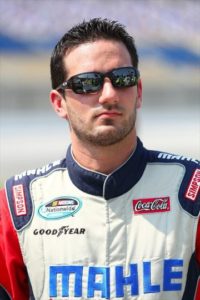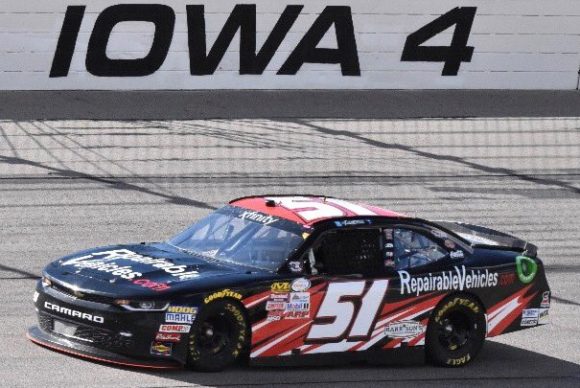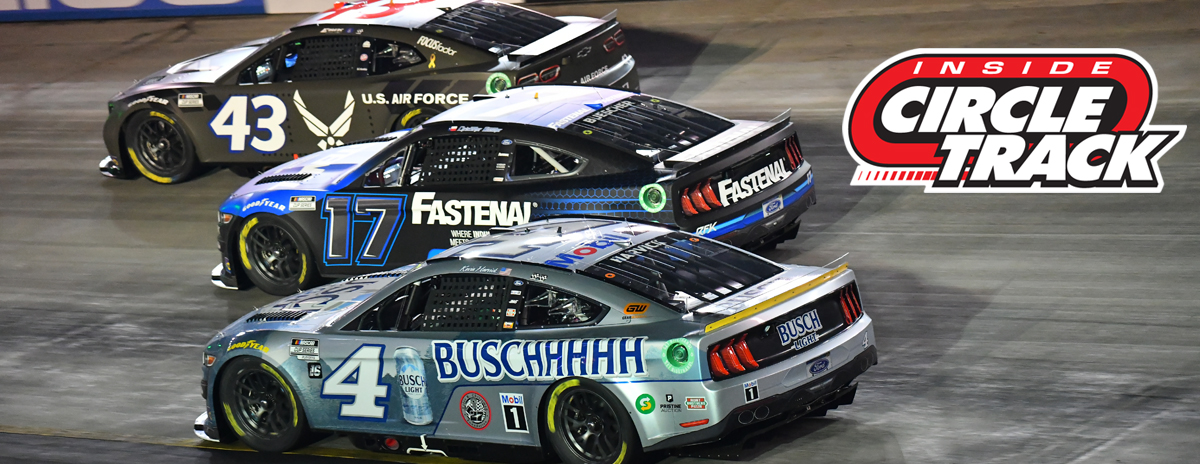This is the first of two pieces based on an interview done with NASCAR Xfinity Series regular Jeremy Clements. This driver, himself a former dirt racer, comes from one of the most noteworthy engine building families in the sport of Dirt Late Model racing.

Jeremy Clements
NASCAR Xfinity Series driver Jeremy Clements is coming off his best finish so far in the 2017 season after posting a seventh place result in the American Ethanol E15 250 at the Iowa Speedway last Saturday. It was the first top-10 of the year for the Spartanburg, SC racer who has notched five top-20 finishes during the current campaign.
The driver who began his racing career on dirt is hopeful that the solid outing in Iowa will carry over into upcoming races on the series schedule and provide the impetus for his RepairableVehicles.com-sponsored effort to garner even more finishes near the front of the pack.
The NASCAR Xfinity Series is essentially divided into two parts with the more heavily funded drivers who have affiliations with the Monster Energy NASCAR Cup Series versus smaller teams with no ties to the top level of the sport. Clements is among those who compete in NASCAR’s “second series” without an alliance to any Cup organization.
“I feel great,” Clements replied regarding his result in Iowa during a telephone interview with InsideDirtRacing.com. “I know we needed that as a team. It’s been really tough this season with the added competition with the Cup teams in the series and the different aero package that we’ve been trying to figure out. We were glad to get our first top-10 of the year, for sure. We always seem to get a few and hopefully we can get some more.”
As the Xfinity Series heads to the Daytona International Speedway for the Coca-Cola Firecracker 250, Clements is cautiously optimistic that he can carry the momentum from Iowa to the “World’s Center of Racing” on Friday night. However, the veteran of 247 career series starts knows that racing on a restrictor plate facility such as the 2.5-mile track located in central Florida and its sister track in Talladega, Alabama is accompanied by a set of challenges not faced anywhere else.
“Well, Daytona is one of those tracks where you just never know what’s going to happen,” the 32-year-old racer pointed out. “As long as we can get through the wrecks and survive to be there at the end, we’ll have a shot. Daytona is just a crap shoot. You might bring the car home in a million pieces or you might bring it home all together and have a good run. We hope to be on the better end of that deal this time.”
According to Clements, the mindset of the driver is different when taking on a restrictor plate track opposed to the thought process when competing on the Iowa Speedway or east Tennessee’s Bristol Motor Speedway. The aggression called for on other tracks gives way to a more guarded mentality.
“It’s totally different,” the driver of the No. 51 Chevrolet declared. “I go into every other track thinking I’m going to have to drive hard and thinking of where I need to let off and get on the brake and where the groove is. But going to Daytona, you just think this is a beast of its own.”
While having a fast car at Daytona is important, the driver who finished in the fourth position at Talladega in 2016 advises that intelligence, luck, and having a good game plan are just as vital to success on the big tracks as raw speed.
“You’ve got to try to be smart,” Clements insisted. “I’ve done different things with different strategies and sometimes it has worked and sometimes it hasn’t. I watch a lot of Cup practice and see what those guys do. There’s no right answer because I’ve tried laying back and just riding but then you get caught a lap down because you lost the draft. But sometimes it worked out that there was a big wreck and you avoided it. I don’t know, but I guess you’ve just got to make a plan and stick with it. I know how this race always goes. At the start of it I’ll try to just sit back and see how it goes then all of a sudden you’re three-wide ten rows deep with people battling like it’s the last lap. That’s when you tell you’re spotter that you’ve got to get out of this.”

Jeremy Clements in his No. 51 Chevrolet
Clements, who finished 15th in Xfinity Series points last season and now resides in the 16th position in the standings for this year, says that one of the biggest hurdles his small team must face is not necessarily going up against Monster Energy NASCAR Cup Series drivers. Instead, it is the Cup organizations providing the cars for those drivers that pose the greatest threat to teams such as Jeremy Clements Racing.
Cup teams such as Joe Gibbs Racing, Richard Childress Racing, and Roush Fenway Racing who also field Xfinity cars for either their own Cup drivers or other competitors have a number of significant advantages over teams with less funding and depth.
“There’s a big difference there,” Clements said of the comparison between his team and those with Cup affiliations. “I’ve got four full-time employees and three of those travel. We have another guy who meets us at the track. We usually have five including my dad at the track. In the shop, we usually have four full-time guys. And then the pit crew comes in before the race. That’s a totally separate deal.
“In comparison, teams like Gibbs or RCR have hundreds of people at their shop and then at the track it seems like they’ve got twelve or fifteen people on each car,” Clements continued. “So it’s a big difference in manpower and they have multi-million dollar sponsors. They probably get more for two races than what we get for a full year.”
However, the No. 51 organization has one advantage over other Xfinity-only teams. Clements Racing Engines is one the best known and most successful power plant builders in the Dirt Late Model racing business. Those resources are also used to provide the motors for Clements’ Xfinity ride.
“Building our own engines saves us a lot of money,” the driver explained. “That’s how we’re really able to do this.”
Clements went on to describe an example of just how much having one of those big organizations behind a driver matters.
“The problem comes from racing against the Cup teams, but the drivers are really good too,” he said. “But go back to when Kyle Busch owned his own team. He didn’t win a single race. They won a race with Kurt Busch driving at Richmond, but he didn’t win one at all. Then you put him in a Gibbs car and it seems like he wins every other race he’s in. That shows how big of a difference it is to drive for a Cup team opposed to an independent even though he had millions of dollars from Toyota and his sponsors.
“I always say it’s almost impossible to race against Cup teams because they have all the technology, the money, and the people,” he added. “You can’t beat that. So unless we’re just on our game 100% and the car is perfect, we’re not going to be able to beat them, honestly. We can sometimes, but most of the time it’s tough.”
So some might be led to ask why this driver who won an ARCA race in Nashville back in 2007 has chosen to compete in the difficult world of NASCAR when he could race elsewhere more easily.
“I raced Dirt Late Models for a long time and I really love that. It’s something I feel like I can always go back to. But you’ve got to take a shot while you’re young to race in NASCAR and try to make it work. Xfinity pays better than trucks and it can sustain itself as long as you’re not wrecking cars. And like I said, building our own engines makes a huge difference. The way we do it, we can make a profit at the end of the year. And, we can run good in a lot of these races. I want to keep that going as long as possible and I’d like to race in Cup one day as well. Like I said, I can always go back to dirt. Dirt is the most fun type of racing, in my opinion.”
Richard Allen is a member of the National Motorsports Press Association
Respond to this piece on Twitter –> @RichardAllenIDR
